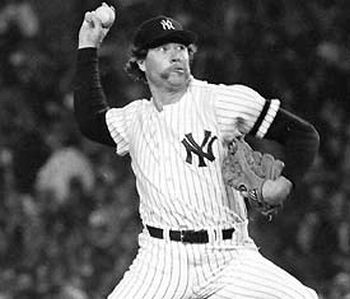Consider The Source When It Comes To Canseco's Aim At Ordonez
Jose Canseco has always been a cartoon.
He was a freakish hulk at the plate, waggling his bat with that wide-open stance, with those Popeye forearms of his. He played the outfield with an iron glove. Once, a ball bounced off his head and went over the fence for a homerun. I'm sure they have replays of it on YouTube. In Yankee Stadium one evening, he left the on-deck circle to confront a fan who shouted some things about Canseco and his wife and Madonna. He tried pitching once. And he was a World Champion, in 1989 with the A's. He mounted several comebacks, and was a journeyman player by the time his career ended.
It hasn't gotten much prettier to look at after he hung up his jockstrap.
So consider the source -- and arm yourself with a whole canister of salt -- when you hear Canseco speak of "outing" former and current players in his self-generated and perpetuated steroids scandal.
But what he purportedly tried to do to the Tigers' Magglio Ordonez has made Canseco less of a cartoon and more of a bad horror movie.

Canseco's blatant extortion attempt on Ordonez will likely backfire on him
It seems that Canseco "asked" Ordonez, last summer, to invest money in a film project Canseco was spearheading. The project was about steroids in baseball. Only, it was inferred that if Ordonez said no, he would find himself in Canseco's new tell-all book.
Extortion isn't the stuff of cartoons.
Ordonez, it was reported, approached GM Dave Dombrowski about the "offer", but neglected to press charges. Maggs didn't want to make a mountain out of a mole hill, apparently. That's very admirable, but it sorta IS a mountain when someone is using such heavy-handed methods to get money from you.
Canseco's book comes out in March, at which time we'll all find out to what extent Ordonez is mentioned in it. But revelations of Canseco's extortion attempt against the 2007 MLB batting champion significantly harms the credibility of the book -- even if the information in it is 100% factual. Canseco now comes off looking as someone more interested in financial gain than in trying to expose wrongdoing in baseball. Why else would he try these scare tactics with Ordonez?
We'll see how much of a distraction, if any, Canseco's book will be to Ordonez and the Tigers. But if you're worried, take comfort in the fact that, thanks to Canseco's boneheaded ploy, Ordonez now looks victimized, as opposed to about to be exposed and vilified.
Looks like Canseco plays life the way he played the outfield: clumsily.
He was a freakish hulk at the plate, waggling his bat with that wide-open stance, with those Popeye forearms of his. He played the outfield with an iron glove. Once, a ball bounced off his head and went over the fence for a homerun. I'm sure they have replays of it on YouTube. In Yankee Stadium one evening, he left the on-deck circle to confront a fan who shouted some things about Canseco and his wife and Madonna. He tried pitching once. And he was a World Champion, in 1989 with the A's. He mounted several comebacks, and was a journeyman player by the time his career ended.
It hasn't gotten much prettier to look at after he hung up his jockstrap.
So consider the source -- and arm yourself with a whole canister of salt -- when you hear Canseco speak of "outing" former and current players in his self-generated and perpetuated steroids scandal.
But what he purportedly tried to do to the Tigers' Magglio Ordonez has made Canseco less of a cartoon and more of a bad horror movie.

Canseco's blatant extortion attempt on Ordonez will likely backfire on him
It seems that Canseco "asked" Ordonez, last summer, to invest money in a film project Canseco was spearheading. The project was about steroids in baseball. Only, it was inferred that if Ordonez said no, he would find himself in Canseco's new tell-all book.
Extortion isn't the stuff of cartoons.
Ordonez, it was reported, approached GM Dave Dombrowski about the "offer", but neglected to press charges. Maggs didn't want to make a mountain out of a mole hill, apparently. That's very admirable, but it sorta IS a mountain when someone is using such heavy-handed methods to get money from you.
Canseco's book comes out in March, at which time we'll all find out to what extent Ordonez is mentioned in it. But revelations of Canseco's extortion attempt against the 2007 MLB batting champion significantly harms the credibility of the book -- even if the information in it is 100% factual. Canseco now comes off looking as someone more interested in financial gain than in trying to expose wrongdoing in baseball. Why else would he try these scare tactics with Ordonez?
We'll see how much of a distraction, if any, Canseco's book will be to Ordonez and the Tigers. But if you're worried, take comfort in the fact that, thanks to Canseco's boneheaded ploy, Ordonez now looks victimized, as opposed to about to be exposed and vilified.
Looks like Canseco plays life the way he played the outfield: clumsily.













 Proud Member of DIBS
Proud Member of DIBS
